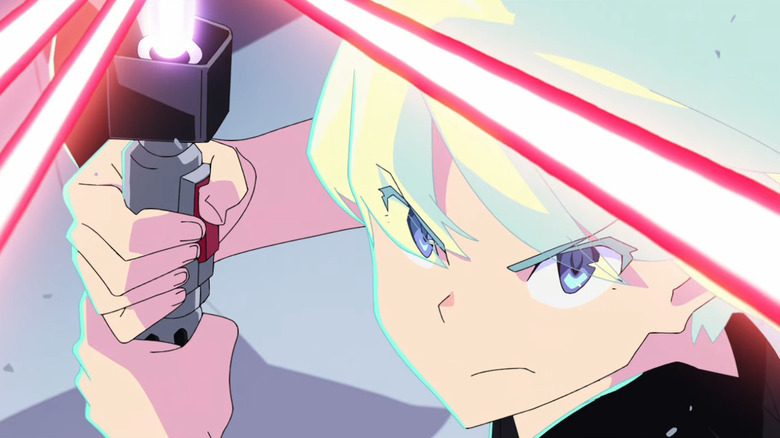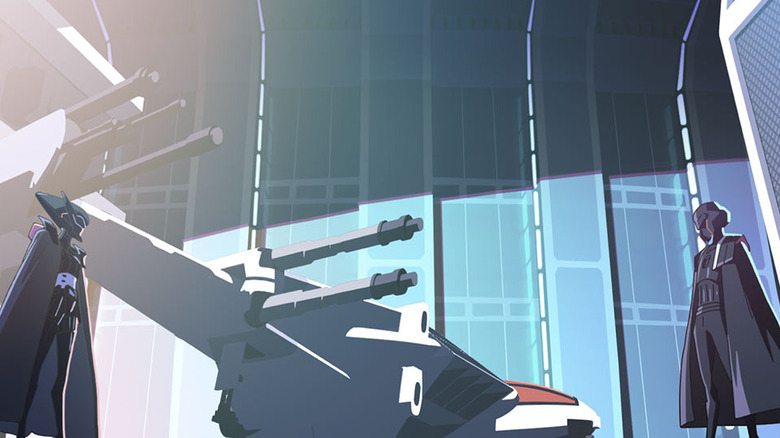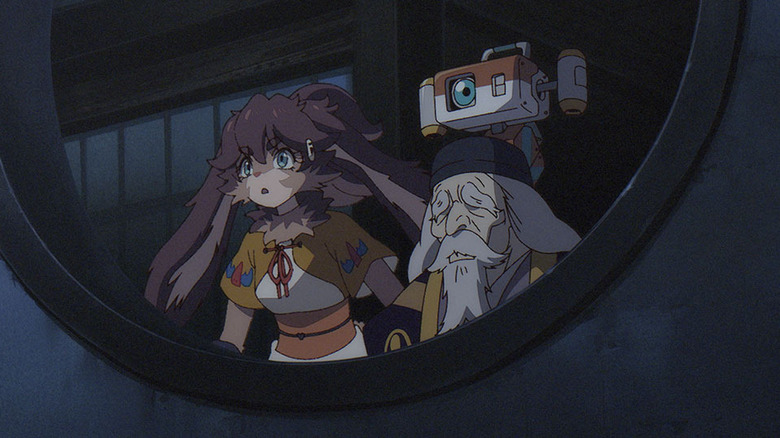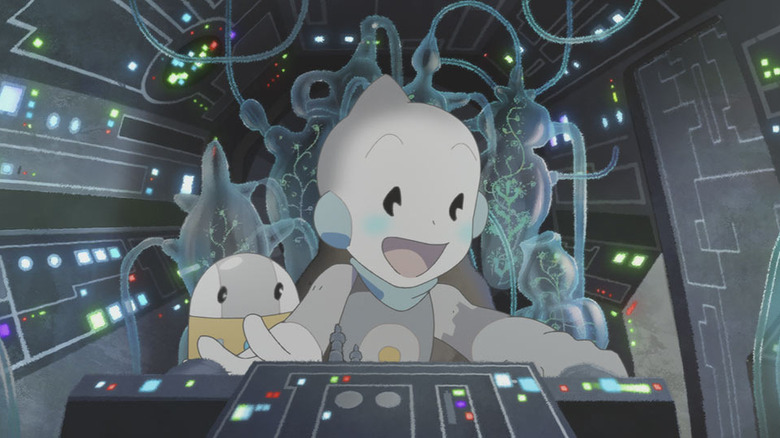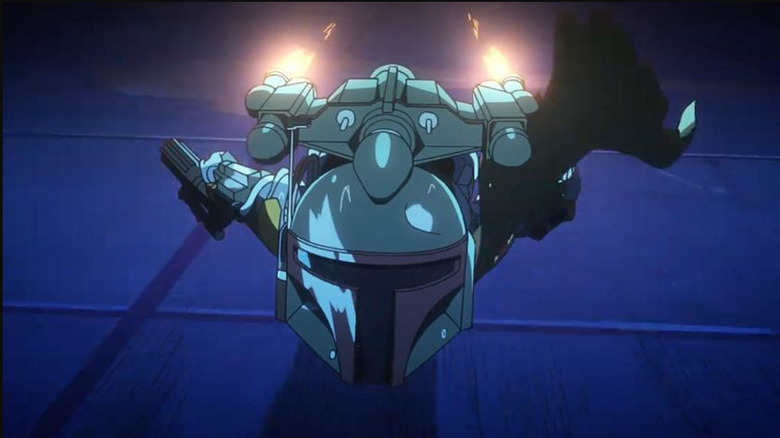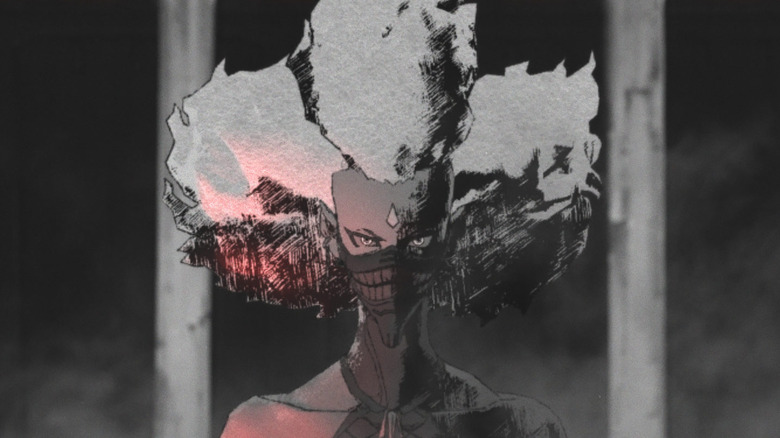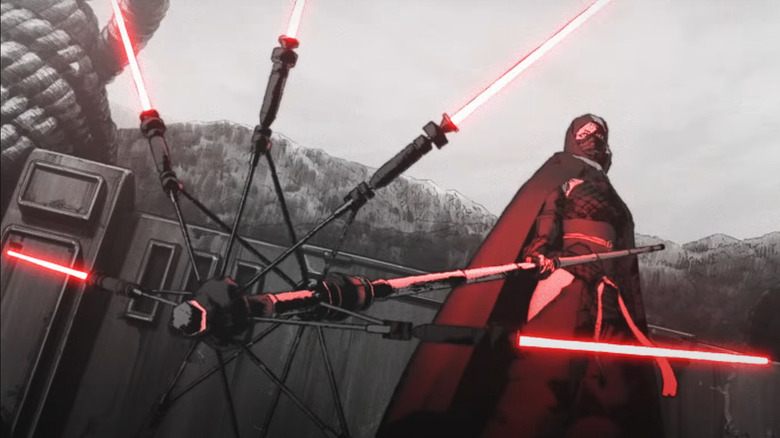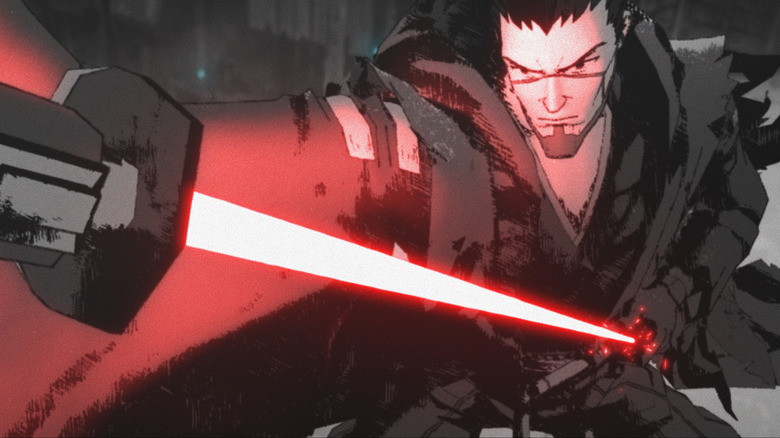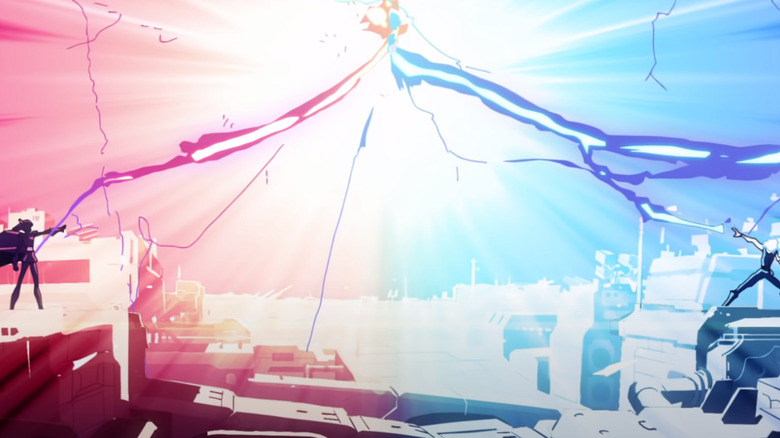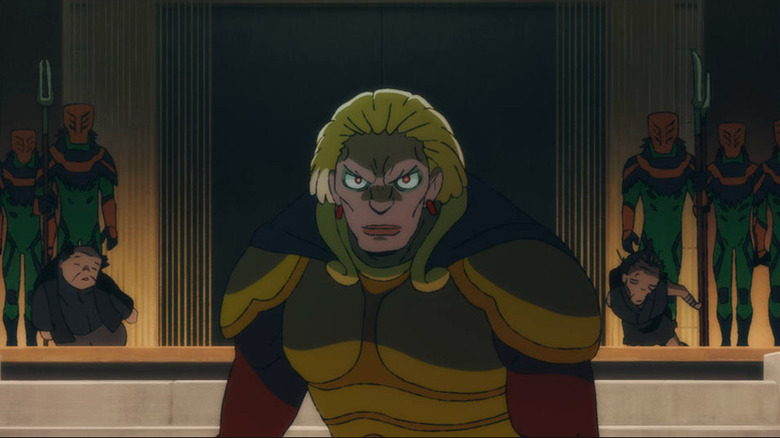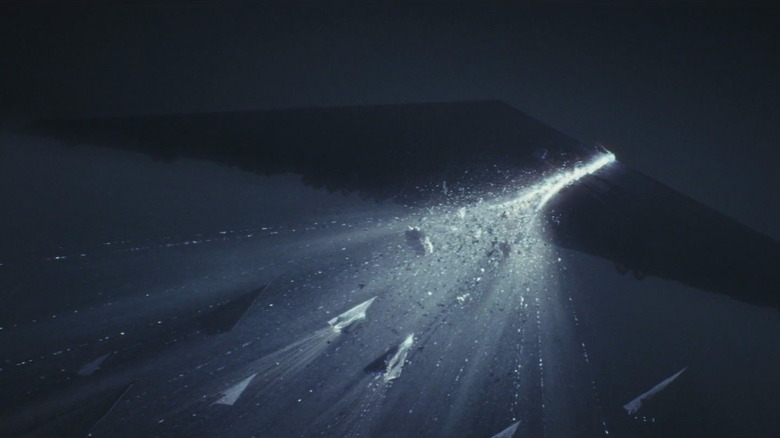Details You Missed In Star Wars: Visions
After more than 40 years of stories set in a galaxy far, far away, fans finally have "Star Wars" anime. With the premiere of "Star Wars: Visions" comes nine shorts from some of the biggest names in anime production showcasing their own breathtakingly adventurous spins on the cultural mythology.
It's no secret that Japanese history and culture has inspired "Star Wars" over the years, all the way back to the creation of the first "Star Wars" movie itself and filmmaker Akira Kurosawa's influence on creator George Lucas, who imposed the influence of samurai legend on the origins and motivations of the Jedi and Sith.
Much of "Star Wars: Visions" puts those influences center stage, celebrating and combining the mythos of "Star Wars" with Japanese iconography that feels seamless and a long time coming. Without the confines of canon, the creators went wild with their own takes, elevating and experimenting with the essence of "Star Wars."
There are Force-flipped, reimagined takes on classic "Star Wars" character tropes in "The Twins" and "Akakiri." And, nearly every short features a twist on Jedi and Sith lore, especially "The Ninth Jedi," "The Elder," "The Duel" and "T0-B1."
One short, "Tatooine Rhapsody," features new takes on some classic characters like Jabba the Hutt and Boba Fett. Others reconstruct classic "Star Wars" stories and metaphors like Republic vs. the Empire and good vs. evil in mythical battles between the Jedi and Sith.
Through all nine shorts is the thread of adventurous mysticism that connects them, all brought to life with top-notch animation art styles. And given all the dazzling visuals on display, it's understandable that there are some details you may have missed in your first watch of "Star Wars: Visions."
Spoilers ahead for "Star Wars: Visions"!
The quotes
Besides the laser swords, sassy droids, and dynamic sides of the Force, "Star Wars" is best known for its quotable dialogue. Some lines are cheesy and even cringeworthy ("I don't like sand" and other Anakin Skywalker kickers) while others are so unique and memorable that they've become part of our larger cultural consciousness. Think of "may the Force be with you" and "No, I am your father."
Luckily, "Star Wars: Visions" steers clear of groan-inducing one-liners. Rather, it continues the fan-favorite running gag of including variations of the line "I have a bad feeling about this" as well as a twist on a famous saying by Master Yoda.
The phrase "I have a bad feeling about this" appears in some form in every major "Star Wars" film and appears many times in other "Star Wars" media, including spinoff TV shows, books, and comic books. "Visions" keeps the gag going by including "I have a bad feeling about this" in at least four of the series shorts — "The Twins," "The Village Bride," "T0-B1," "Tatooine Rhapsody" and "The Elder."
"The Twins" in particular includes a variation of "I have a bad feeling about this" and one on Yoda's famous quote, "do or do not, there is no try." These lines are spoken quickly and consecutively, so they're easy to miss on the first watch.
Dark lord Karre asks his droid R-DUO "Really ... so you have a bad feeling about this?" after narrowly escaping the Imperial Twin Star Destroyer and the clutches of his dark side twin sister, Am, with a stolen Kyber crystal power core. Later in the short, as Am's armor becomes overloaded with the dark side power of the Kyber crystal, Karre questions his ability to save his sister by using his X-Wing's hyperdrive and his lightsaber. But R-DUO lets loose some encouraging beeps, and Karre replies, "It's just like you say, R-DUO: there is no try, only do."
The droids
"Star Wars" wouldn't be "Star Wars" without its droids. While not always main characters, the droids of "Star Wars" have been fan favorites ever since C-3PO and R2-D2 landed on Tatooine in an escape pod during "A New Hope."
Fittingly, the droids are the breakout stars of "Star Wars: Visions." In "Tatooine Rhapsody," K-344 is the guitarist of the Star Waver band rocking a dual-neck guitar. "Visions" producer Kanako Shirasaki has described K-344 as calm and cryptic, "but her affinity for rock and roll shines through" when she and her band members face a tough choice.
Then there are several very different droids that reimagine the classic traits and personalities of R2-D2 and C-3PO. In the short "Lop and Ochō," the droid TD-4 is a loyal companion to Lop, whose journey highlights the classic found family trope seen throughout "Star Wars." TD-4 also showcases a twist on R2-D2's recording tool by capturing key moments of Lop's life and playing them back via holo. TD-4 is almost like a droid diary.
Then there are the reimagined R2-D2 and C-3PO droids in "The Twins" — R-DUO and B-2ON. The latter, instead of being shiny gold, is a jet black protocol droid that serves the dark side twins Am and Karre. Clearly inspired by the original C-3PO, B-2ON's name consists of the letters and the number that come before those in the former protocol droid's name.
B-2ON's counterpart, R-DUO, clearly takes after R2-D2 in his mischievousness and dedication to the Luke side of this duo, Karre. Like R2-D2, R-DUO is a friend to Karre, who understands the droid's importance in his life and in the battles to come.
Astro-Boy meets Pinocchio
The most standout droid star in "Star Wars: Visions" is T0-B1, a chibi-style humanoid droid whose story echoes Pinocchio and the manga series "Astro-Boy." As an assistant to a professor on a barren planet, T0-B1's role is to help his master bring life back to the world.
While the story of Pinocchio and Astro-Boy shows a character striving for acceptance and hoping to become a "real boy," the adorably curious and precocious droid T0-B1 has big dreams of becoming a Jedi Knight. Professor Mitaka indulges the boy's dreams by regaling him with tales of the legendary Jedi and the power of the Force.
Covering much of the walls of T0-B1's room are carvings of star fighters, Imperial ships like TIE fighters, stormtroopers, and stick figure Jedi wielding long, thin laser swords. The dark side characters, notably, are drawn darker. Also, blink and you might miss a carving of the ziggurat Jedi Temple, the many-tentacled Sarlacc, a figure hoisting a glowing lightsaber a la Luke Skywalker, and several looming Star Destroyers and Imperial armored walkers.
Essentially, T0-B1's walls roughly tell the story of the Skywalker saga through key moments and figures from the prequel films, original trilogy, and sequels.
The cameos
Out of all nine shorts in "Star Wars: Visions," "Tatooine Rhapsody" is the one that leans heaviest on cameos from canon characters. Set between the prequel films and the original trilogy, the short follows a space rock group hoping to make it big while simply trying to survive on the crime-filled world of Tatooine.
While the band members are the stars of the show, the short's setting in Mos Espa makes it ripe for cameo-spotting. The most blatant come from Boba Fett and Jabba the Hutt — both depicted here in a more chibi style. Keep an eye out for pale Twi'lek boss Bib Fortuna and Jabba's Gamorrean guards, and there are also brief glimpses of a lumbering bantha, a few Jawas, and the famous Figrin D'an and the Modal Nodes band watching Star Waver's concert from inside the Mos Eisley cantina.
The other "Visions" shorts mostly stick to introducing new characters, but a couple of them feature "Clone Wars" and "Rebels"-era characters. "The Village Bride" notably presents a unique take on the Separatists' takeover of Outer Rim planets and includes cameos by a group of bumbling attack droids still saying "roger, roger." And the short "T0-B1" features a reimagined Inquisitor post-Order 66, made all the more menacing with black, Medieval-esque armor.
The voice talent
Do the characters of "Star Wars: Visions" sound familiar? They should, because the nine shorts are full of celebrities and famous voice actors.
Notably, Lucy Liu voices the Sith Bandit Leader in "The Duel," Joseph Gordon-Levitt and Bobby Moynihan star in "Tatooine Rhapsody," Neil Patrick Harris and Alison Brie lead "The Twins," Kyle Chandler is the professor in "T0-B1," David Harbour and Jordon Fisher voice a master and a padawan in "The Elder," and George Takei is featured in "Akakiri."
"The Ninth Jedi" also features "Shang-Chi" star Simu Liu voicing the character Zhima. You'll also hear Boba Fett himself, Temuera Morrison, voicing the notorious bounty hunter in "Tatooine Rhapsody" alongside popular "Star Wars" voice actor Marc Thompson as the three-bodied drummer Lan.
The Japanese dub of "Visions" also includes legends of the anime industry like Masako Nozawa ("Dragon Ball," "The Duel"), Megumi Han ("Hunter x Hunter," "The Village Bride"), and Junya Enoki ("Jujutsu Kaisen," "The Twins").
The lightsabers
Every "Visions" short has at least one lightsaber, and almost every one of them includes a laser sword duel. As "Visions" didn't have to adhere to the continuity of "Star Wars," the anime creators likewise didn't have to stick to tradition when it came to crafting lightsabers.
"The Duel" has the most unique lightsabers, with the wandering Ronin character wielding a red blade that he sheaths in a scabbard and the Sith Bandit Leader terrorizing with a retractable umbrella that sports what looks like at least eight spinning lightsabers. The titular character in "The Elder" wields two bright red Katana-like lightsabers despite balking at being called a Sith. More blade-like lightsabers and ones of differing colors are seen in "Lop and Ocho," "The Village Bride," and "Akakiri."
In "The Twins," the lightsabers are mostly classic looking, but dark side twin sister Am also becomes a lightsaber in a way by joining a massive Kyber crystal with her armor. The weaponized armor allows her to channel and wield the deadly dark side power while popping out a few mechanized limbs that make her look like a Sith Spider-Man.
In "The Ninth Jedi," the mysticism of the Force and Kyber crystals is reimagined and put center stage as a master saber-smith crafts lightsabers with blades that grow and brighten depending on the power of the wielder. Those who are strong in the light side of the Force will prompt bright green or blue blades, while those who serve the dark side will get red ones. It's an interesting way to depict the idea that everyone is connected to the Force in some way.
Japanese iconography
The Japanese cultural influence in "Star Wars" is stark. The Jedi are clearly based on Edo period samurai, with nods to the historic warriors in their attire, their peacekeeping, and their swords. "Star Wars" creator George Lucas has also been transparent about the inspiration he found in Akira Kurosawa's "The Hidden Fortress" from 1958, especially its story being told "from the (perspective of) the two lowest characters." The first "Star Wars" movie, "A New Hope," begins the story from the point of view of two droids, R2-D2 and C-3PO.
"Star Wars: Visions" elevates this tradition by giving the spotlight to Japanese studios to tell the galaxy's stories through the lens of anime. Coming from seven different studios, each "Visions" short showcases a different anime style — from the cute and caricature-like chibi style of "T0-B1" and "Tatooine Rhapsody" to the more traditional hand-drawn black and white sketching of "The Duel."
"The Duel" notably melds samurai lore with space opera elements like the sword-wielding Ronin (a ronin in Japanese history is a masterless samurai) and his companion droid wearing a straw hat reminiscent of ones worn by wandering samurai in feudal Japan. In another short, "The Village Bride," one character is seen wearing a reimagined metal bucket-style hat similar to the tengai worn by komusō monks during the Edo period.
Throughout "Visions," the lightsabers are made to look more like actual swords, such as katanas, rather than just beams of laser light. And "Akakiri" is grounded in the look of 'The Hidden Fortress'" and other samurai films, especially in its characters' journey trying to avoid wandering bandits and their quest to defeat a menacing dark side warlord. "Akakiri" also shows the main characters traveling in what looks like a traditional Japanese river boat instead of high-flying starships.
Luke and Leia reimagined
"The Twins" short is chock full of unique spins on classic "Star Wars" motifs, chiefly the story of twins Luke and Leia saving the galaxy from the darkness their father helped create.
Instead of Luke and Leia, the short follows Karre and Am — twins not born of love but rather created by the dark side in order to restore its hold on the galaxy. In flashbacks so quick you'll miss them if you blink, we see scenes of Karre and Am's "conception" and brief looks at who orchestrated their births. Since "The Twins" takes place after "The Rise of Skywalker," it could be safe to assume the hooded figures accompanying Karre and Am in these flashbacks are members of the Sith Eternal cult, which was destroyed in the Battle of Exegol.
Other "Twins" elements that are similar to Luke and Leia's story include Karre and Am's connection to the Force and their droid companions, as well as the way Karre's love for Am overpowers his upbringing as a tool for the remnants of the Imperial army and all-consuming greed for more power. This compassion in Karre reflects Luke's behavior towards Darth Vader, especially his dogged insistence that there's still good left in his father and his willingness to do anything to save him.
Karre will do anything to save his sister, no matter how dangerous. The short ends with an anime twist on an iconic "Star Wars" shot — Karre, atop his crashed X-Wing with R-DUO, watching twin suns set on a desert planet and expressing hope that Am is still alive because "I can feel it ... she's my twin sister."
Padme and Anakin reimagined
The short "Akakiri" is a beautiful and heartbreaking story about a princess and Jedi, their bittersweet love, and the lengths they'll go to save one another. It's a captivating twist on the fraught love story of Padme Amidala and Anakin Skywalker, complete with Jedi Tsubaki (Henry Golding) having painful visions about Misa (Jamie Chung) and Misa sporting attire and a hairstyle similar to Padme.
In echoes of Queen Amidala's dangerous mission to help free her people during the Battle of Naboo, Misa and Tsubaki embark on a journey to reclaim the palace from the clutches of Sith warlord Masago, who was a member of the royal family. In an epic final battle against Masago, Tsubaki inadvertently kills Misa when she's shoved in front of him while wearing a mask.
Like Anakin destroying Padme's will to live, Tsubaki kills Misa in his anger and desire for revenge. Like the Emperor, Masago offers Tsubaki the power to bring Misa back to life — if he joins her as her right hand and uses the dark side to rule the galaxy. On his knees, Tsubaki begs, "Please, help me save her ... my master" before becoming Masago's Sith apprentice.
The Holdo Maneuver
With so many nods to the "Star Wars" that came before it, it's no surprise that "The Twins" short also features the reappearance of a legendary offensive move first seen in "The Last Jedi."
Dubbed "the Holdo maneuver," the suicidal tactic was used when Vice Admiral Amilyn Holdo sacrificed herself to save the Resistance fleet by flying at lightspeed straight at a First Order Star Destroyer. Her gambit worked — her ship ripped through the destroyer, wiping out more than a dozen others nearby in the process.
In "The Twins," Karre uses the Holdo maneuver on the Twin Star Destroyer in order to save his sister Am from the deadly dark side power of the Kyber crystal pulsing through her weaponized armor. Using his lightsaber and his X-Wing, Karre channels the hyperdrive's power and destroy Am's armor and the Kyber crystal within, flinging his sister out into the rubble orbiting the ship.
As for the Twin Star Destroyer, its starboard wing is sliced off by the X-Wing's ramming it at lightspeed. And, like in "The Last Jedi," the scene pans to show the awesome destruction of the move, which nearly sheared the ship in two. Unlike Vice Admiral Holdo, Karre survives.
